The History of San Francisco's Public Libraries and Their Impact

The Early Beginnings of San Francisco's Library System
San Francisco's public library system began in the mid-19th century, with the establishment of the Mercantile Library Association in 1850. This early library served as a vital resource for the city's growing population, particularly during the Gold Rush era. While it was initially a private institution, the need for public access led to significant changes in how libraries operated.
A library is not a luxury but one of the necessities of life.
In 1878, the San Francisco Public Library was officially founded, marking a turning point for public access to books and resources. The library was intended to cater to a diverse community, reflecting the city’s rapid expansion and influx of immigrants. This commitment to inclusivity laid the groundwork for the library's future role as a community hub.
Over the years, the library continued to evolve, with the construction of the main library building in 1898. This new space not only housed books but also served as a cultural center, offering various programs and events. The dedication to fostering a love for reading and learning became a hallmark of San Francisco's library system.
The Role of Libraries in the Community
San Francisco's public libraries have long been more than just places to borrow books; they are vital community centers. They offer programs for people of all ages, from storytime for children to digital literacy classes for seniors. By providing these services, libraries help bridge educational gaps and foster lifelong learning.

Moreover, libraries serve as safe spaces for individuals seeking refuge from the hustle and bustle of city life. Many residents find solace in the quiet corners of libraries, turning them into personal sanctuaries for reading or studying. This welcoming environment has made libraries a cornerstone of community engagement.
Libraries as Community Hubs
San Francisco's libraries serve as vital community centers, offering programs that promote lifelong learning and foster inclusivity.
The impact of these libraries extends beyond their walls, as they often partner with local organizations to host events and workshops. These collaborations strengthen community ties and ensure that the library remains a relevant and integral part of San Francisco's social fabric.
Challenges Faced by San Francisco's Libraries
Throughout their history, San Francisco's libraries have faced significant challenges, including funding issues and the need for modernization. Economic downturns often led to budget cuts, which affected staffing and resources, limiting the services they could provide. Despite these obstacles, the libraries have persevered, adapting to changing needs.
Libraries are the backbone of our democracy. They are places where people can come together to learn, share, and grow.
In recent years, the rise of digital media has prompted libraries to reevaluate their roles. While some feared that the internet would render libraries obsolete, San Francisco's public libraries embraced technology, offering e-books and online databases. This shift not only attracted a younger audience but also ensured accessibility for all citizens.
Additionally, the libraries have had to confront issues surrounding homelessness and mental health. By providing resources and outreach programs, they strive to create a supportive environment for everyone. This commitment to inclusivity highlights the libraries’ essential role in addressing community challenges.
The Architectural Evolution of Library Spaces
The architectural journey of San Francisco's libraries reflects the city's history and cultural evolution. The original main library, with its classic design, stood as a symbol of knowledge and community pride. As the city grew, so did the need for larger, more functional spaces, leading to various expansions and renovations.
In 1996, the new Main Library opened, boasting a modern design and an array of amenities. This facility was crafted to accommodate the increasing number of visitors and the demand for diverse resources. With designated spaces for children, teens, and adults, the library became a dynamic environment for learning and collaboration.
Adaptation to Modern Challenges
Despite facing funding and modernization challenges, San Francisco's libraries have embraced technology to remain relevant and accessible.
Today, many branch libraries feature unique architectural styles that mirror their neighborhoods, enhancing the community's character. These spaces not only serve practical functions but also inspire creativity and exploration. The design of each library reinforces its role as a welcoming and inclusive space for all.
Library Programs and Their Cultural Impact
San Francisco's libraries host a myriad of programs that enrich the cultural landscape of the city. From author readings and art exhibitions to language classes and book clubs, these events bring diverse communities together. This cultural programming fosters an appreciation for literature and the arts, making the libraries vibrant community hubs.
Particularly notable is the library's commitment to promoting local authors and artists. By providing a platform for these creatives, libraries help cultivate a sense of pride and ownership within the community. This initiative not only supports local talent but also invites residents to engage with their cultural heritage.
Moreover, the libraries' focus on inclusivity ensures that everyone, regardless of background, has access to cultural enrichment. By offering programs in multiple languages and targeting underrepresented communities, the libraries play a crucial role in fostering understanding and unity among San Francisco’s diverse population.
The Future of San Francisco's Public Libraries
As we look ahead, the future of San Francisco's public libraries is filled with both opportunities and challenges. With the rise of technology, libraries are poised to become even more integral to digital learning and access. This evolution will likely include continued investments in digital resources and innovative programs to meet the needs of a tech-savvy population.
Furthermore, the libraries' commitment to inclusivity will remain paramount. As demographics shift, libraries will need to adapt their services to cater to an increasingly diverse community. This may involve expanding language programs, community outreach, and partnerships with local organizations to ensure that everyone feels represented.
Cultural Programming Impact
The libraries host diverse cultural programs that enrich the community, promote local talent, and foster understanding among residents.
Ultimately, San Francisco's libraries are not just repositories of books, but dynamic spaces for learning, cultural exchange, and community connection. Their resilience and adaptability promise a bright future, one where they can continue to thrive and positively impact the lives of residents for generations to come.
Conclusion: Celebrating the Legacy of San Francisco's Libraries
In conclusion, the history of San Francisco's public libraries is a testament to their enduring significance in the community. From their humble beginnings to their present-day status as cultural beacons, these libraries have consistently adapted to meet the needs of their patrons. They have become essential spaces for learning, creativity, and connection.
As we celebrate their legacy, it's important to recognize the challenges they have faced and overcome. The continued support from the community and city officials will be crucial in ensuring that these libraries remain vibrant and accessible for future generations. By investing in our libraries, we invest in the heart of our community.

Looking forward, San Francisco's public libraries will undoubtedly continue to evolve, embracing new technologies and ideas. However, their core mission—to foster a love for reading and learning in an inclusive environment—will always remain. Together, let's honor and support the important role these libraries play in shaping a brighter future for all.